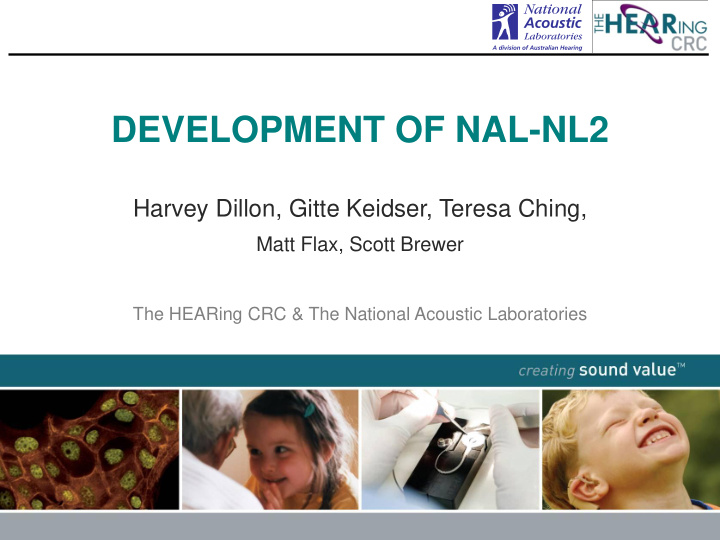



DEVELOPMENT OF NAL-NL2 Harvey Dillon, Gitte Keidser, Teresa Ching, Matt Flax, Scott Brewer The HEARing CRC & The National Acoustic Laboratories creating sound value TM www.hearingcrc.org creating sound value TM
Prescribe hearing aids to: • Make speech intelligible • Make loudness comfortable • Prescription affected by other things – localization, – tonal quality, – detection of environmental sounds, – naturalness. creating sound value TM
Deriving optimal gains - step 1 Loudness Speech spectrum Normal model & level loudness Gain-frequency Compare response Intelligibility achieved Loudness Intelligibility Loudness Amplified speech (hearing model model spectrum impaired) Audiogram creating sound value TM
The audiograms Rejection criterion : -30<= G <=60 , where G is the slope sum(H(f))/3 <=100 , where f is in the set {0.5, 1, 2} kHz Inverted hearing loss profiles used creating sound value TM
Deriving optimal gains - step 1 Audiogram 1 Speech level 1 Optimal gain frequency response Audiogram 1 Speech level 2 Optimal gain frequency response Audiogram 1 Speech level 3 Optimal gain frequency response Audiogram 2 Speech level 1 Optimal gain frequency response 200 audiograms x 6 speech levels 1200 gain – frequency responses, each at 20 frequencies from 125 Hz to 10 kHz creating sound value TM
Overall prescription approach Psychoacoustics Theoretical Final Assumptions, Adjust predictions formula rationale Compare Speech science Empirical observations creating sound value TM
Limiting compression ratio creating sound value TM
Multi-dimensional equation A neural network H 250 H 500 H 1000 H 2000 H 8k SPL G 250 G 500 G 1000 G 2000 G 8k creating sound value TM
The two key ingredients Loudness Speech spectrum & Normal model level loudness Gain-frequency Compare response Intelligibility achieved Loudness Intelligibility Loudness Amplified speech (hearing model model spectrum impaired) Audiogram creating sound value TM
Psychoacoustics creating sound value TM
Why are hearing thresholds so useful? Frequency selectivity Temporal resolution Speech Hearing Perception thresholds proficiency Central auditory processing Age Other Cognitive ability creating sound value TM
BKB, VCV and CUNY creating sound value TM
Factors affecting prescription creating sound value TM
Gain; adults, medium input level (N = 187) creating sound value TM
Gain for adults: low & high input levels Smeds et al. 2006 1.5 NAL-NL1 re gain preferred at 65 Zakis et al. 2007 Preferred gain deviation from 1 0.5 dB SPL in dB 0 -0.5 Suggest that the -1 compression ratio should be slightly higher, -1.5 at least for clients with -2 mild and moderate 50 80 hearing loss Input level in dB SPL creating sound value TM
Binaural loudness correction 7 Gain variation (dB) 6 5 4 3 2 1 0 0 20 40 60 80 100 120 Input level (dB) creating sound value TM
Empirical evidence: variations from NAL-NL1 Output level NAL-NL1 Children Adults Input level creating sound value TM
Adults – congenital or acquired? 0 Preferred gain deviation -2 from NAL-RP (dB) -4 -6 -8 Congenital -10 (N=15) Acquired -12 (N=28) -14 LFA HFA creating sound value TM
Effect of language Gain at each frequency depends on importance of each frequency Low frequencies more important in tonal languages Two versions of NAL-NL2 – Tonal languages – Non-tonal languages creating sound value TM
Tonal versus non-tonal language 40 NAL-NL1 35 Insertion gain in dB Male, exp, non-tonal 30 25 Male, exp, tonal 20 15 10 5 0 100 1000 10000 Frequency in Hz creating sound value TM
Example audiogram: moderate sloping Frequency (Hz) 125 250 500 1k 2k 4k 8k 40 0 Insertion Gain (dB) 35 50 dB Hearing threshold (dB HL) 30 20 25 65 dB 40 20 60 15 80 dB 10 80 5 100 0 120 100 1000 10000 Frequency (Hz) creating sound value TM
Example audiogram: flat 60 Frequency (Hz) 125 250 500 1k 2k 4k 8k 40 0 Insertion Gain (dB) 35 Hearing threshold (dB HL) 30 50 dB 20 25 65 dB 40 20 60 15 80 dB 10 80 5 100 0 120 100 1000 10000 Frequency (Hz) creating sound value TM
Example audiogram: steeply sloping Frequency (Hz) 125 250 500 1k 2k 4k 8k 40 0 Insertion Gain (dB) 35 50 dB Hearing threshold (dB HL) 30 20 25 40 65 dB 20 60 15 80 dB 10 80 5 100 0 120 100 1000 10000 Frequency (Hz) creating sound value TM
Example audiogram: extreme ski-slope Frequency (Hz) 125 250 500 1k 2k 4k 8k 35 0 Insertion Gain (dB) 30 50 dB Hearing threshold (dB HL) 20 25 40 20 65 dB 15 60 80 dB 10 80 5 100 0 120 100 1000 10000 Frequency (Hz) creating sound value TM
Example audiogram: reverse sloping Frequency (Hz) 125 250 500 1k 2k 4k 8k 30 0 Insertion Gain (dB) 25 Hearing threshold (dB HL) 20 50 dB 20 65 dB 40 15 60 80 dB 10 80 5 100 0 120 100 1000 10000 Frequency (Hz) creating sound value TM
Variables in NAL-NL2 Age Vent Tube Comp speed WBCT N Language Depth Gender RECD Bi-uni CR RECD BWC Experience REUG Aid type UCT I/O REDD MLE Transducer REIG REAG AC CG AC' ABG ESG BC' RESR ESCD BC SSPL 2cc Blue = User i/p Grey = internal variable SSPL ES Limiting Red = effect of saturation type Dash-dot = alternatives Green = stored data creating sound value TM
“A challenge for the profession is to devise fitting procedures that are scientifically defensible and the challenge for the individual audiologist is to choose the best procedures from whatever are available” Denis Byrne, 1998 creating sound value TM
www.hearingcrc.org Acknowledgements www.nal.gov.au This research was financially supported by the HEARing CRC established and supported under the Australian Government’s Cooperative Research Centres Program creating sound value TM creating sound value TM
Recommend
More recommend